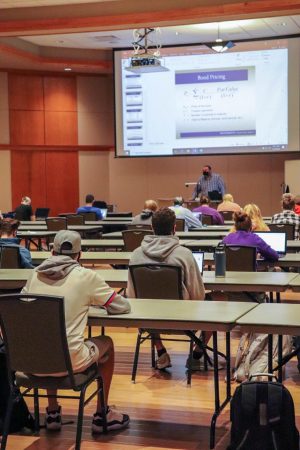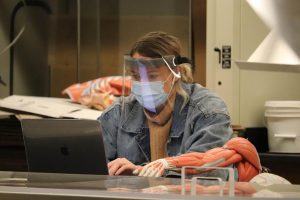Spring classes to follow fall pattern, increase distancing
Nov 5, 2020
Registration for spring 2021 classes is underway, and as UNI students plan their schedules, they will likely encounter a mix of online and in-person classes similar to their fall 2020 courseload.
Associate Provost for Academic Affairs Patrick Pease wrote in an email to the Northern Iowan that the university currently plans to hold about 74% of spring 2021 classes fully in-person, with about 8% hybrid and 18% online.
This compares closely with the distribution of classes during the fall 2020 semester. According to information published by the university at the start of the semester, 80% of classes were scheduled with at least some in-person component.
Pease said that during the spring semester, students and faculty can expect an even greater degree of social distancing in classrooms in a continued effort to prioritize campus safety.
“Individuals will be even further spread apart in classrooms than they are currently,” he wrote. “Most classrooms in spring will have students six feet apart, and the remaining rooms ensure students are within six feet of only one other student.”
The adjusted spring seating plan was developed around the same time that the university implemented classroom changes for over 150 fall semester courses in early September, Pease said.
“In response to concerns we heard a few weeks into the fall semester, we instituted changes in our classroom arrangements to reduce the likelihood of quarantining, and then developed a plan to make classrooms even more distanced for spring,” he wrote. “Since developing the spring seating plan, the Iowa Department of Public Health has relaxed the requirements for quarantining people, recognizing that masks work. While that has been very helpful, we made the decision to continue with the more distanced seating plan during the winter/spring out of an abundance of caution.”
Pease also noted that during the spring 2021 semester, the capacity of each classroom will be reduced to 35% of normal, a slight reduction from the 40% used as a guide for in-person classes this fall. This restriction meant that, as occurred this semester, some classes that would normally be taught in person will be forced to shift online.
Decisions about the best modality for each course were made in “a variety of ways,” according to Pease.
“Departments made strategic choices about which classes would work best in an online format versus those that need to remain in a face-to-face classroom,” he wrote. “Those strategic decisions were based both on course content and the professors’ experience and comfort with online teaching.”
Additionally, faculty members with medical accommodations due to “high-risk circumstances” such as pregnancy or underlying health concerns could apply for telework options and online delivery modes for their classes.
The COVID-19 pandemic has proven that it is impossible to predict how the world will look next week, let alone next semester, but many are continuing to hope for the arrival of an effective vaccine in the new year.
However, Pease said even if a positive shift in public health circumstances were to occur during the spring semester, reducing the risk of large in-person gatherings, online and hybrid courses would likely remain in their scheduled formats to avoid disruption to instruction and student schedules.
“Changing from online to in-person would be difficult for a variety of reasons,” he wrote. “Asynchronous classes would have to be assigned a day and time which would likely conflict with other obligations on students’ schedules. We would also struggle to find classrooms to put the classes in unless we reorganized rooms to seat students closer together…. I believe the best course would be to maintain as much consistency as possible and look to Fall 2021 for the changes.”

















